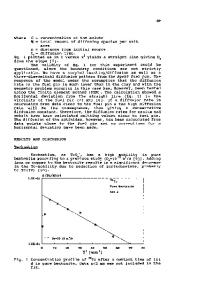Plutonium Migration in Compacted Bentonite with Iron Corrosion for 15 Years
- PDF / 340,409 Bytes
- 6 Pages / 432 x 648 pts Page_size
- 2 Downloads / 273 Views
Plutonium Migration in Compacted Bentonite with Iron Corrosion for 15 Years Kazuya Idemitsu1, Noriya Okubo1, Yaohiro Inagaki1, Tatsumi Arima1, Daisuke Akiyama2, Kenji Konashi3, Makoto Watanabe3 1 Dept. of Applied Quantum Physics and Nuclear Engineering, Kyushu Univ., 744 Motooka, Nishi-ku, Fukuoka, Japan 2 Institute of Multidisciplinary Research for Advanced Materials, Tohoku University, 1-1 Katahira, 2-choume, Aoba-ku, Sendai, Japan 3 International Research Center for Nuclear Materials Science, Institute for Materials Research, Tohoku University, 2145-2 Narita-cho, Oarai-machi, Higashiibaraki-gun, Ibaraki, Japan
ABSTRACT In disposal of high-level radioactive waste, carbon steel overpack will be corroded after closure of the repository, creating a reducing, low-pH environment around the repository. A plutonium diffusion experiment was performed over 15 years with Kunigel V1, which is a typical Japanese bentonite that contains about 50% montmorillonite, in contact with an iron coupon. A tracer solution (10 μL) containing 1 kBq of 238Pu was applied at the interface between the iron coupon and compacted bentonite that was saturated with deionized water. After the diffusion period, the plutonium distribution in the bentonite specimen was measured with an alpha scintillation counter, and the iron and sodium distributions were obtained by inductively coupled plasma-mass spectrometry. Plutonium penetrated into the bentonite to a depth of 2 mm, and more than 90% of plutonium remained in corrosion product at the interface. The bentonite around the interface was dark green like green rust or magnetite according to visual observation. Iron was detected throughout the bentonite and there was a particularly high iron concentration from the interface to a depth of 2 mm, whereas the sodium concentration decreased slightly from the interface to 2 mm. We proposed that ferrous ions diffused into bentonite as the iron coupon corroded and precipitated such as magnetite. The magnetite precipitation would decrease the bentonite pH, resulting in the dissolution and migration of plutonium. Small cracks were also observed 2 to 6 mm from the interface and could have been formed by the migration of hydrogen generated by corrosion. INTRODUCTION In the safety assessment of geological disposal of high-level radioactive waste and spent nuclear fuel in Japan [1], the barrier function of the bentonite buffer and carbon steel overpack in multi-barrier systems is important. The main transport of radionuclides in compacted bentonite is controlled by diffusion; thus, it is important for safety assessments that the diffusion coefficients of radionuclides are estimated. After a high-level radioactive waste repository is closed, the carbon steel overpack forms corrosion products, which may migrate into the bentonite. Iron corrosion products may alter the bentonite, maintain a reducing environment, and decrease the pH in the repository, which may affect migration behavior, especially for redox-sensitive elements such as plutonium. Plutonium is a radiochem
Data Loading...











